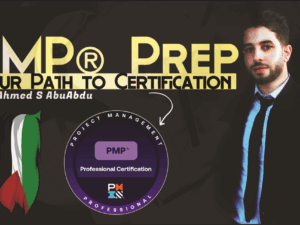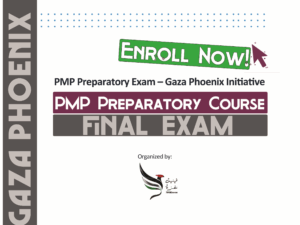Mastering Scrum: Agile Project Management in Action
- Description
- Curriculum
- FAQ
- Notice
- Reviews

Module 1: Introduction to Agile & Scrum
✅ Agile Manifesto & Principles
The Agile Manifesto, introduced in 2001, marked a shift from rigid, documentation-heavy approaches to more adaptive and people-focused project management. It emphasizes four core values:
-
Individuals and interactions are more important than processes and tools.
-
Working software is more valuable than comprehensive documentation.
-
Customer collaboration is prioritized over contract negotiation.
-
Responding to change is better than strictly following a plan.
In addition to these values, there are twelve principles that guide Agile teams. These principles promote early and continuous delivery of valuable products, embracing change even late in development, and fostering daily collaboration between stakeholders and developers. They also highlight the importance of sustainable pace, simplicity, and regular reflection for improvement.
Agile is built on trust, transparency, and continuous learning.
✅ Overview of Agile Methodologies
Agile isn’t a single framework—it’s a mindset supported by various methodologies that reflect its values. The most popular one is Scrum, but others like Kanban, Extreme Programming (XP), and Lean are also widely used depending on the nature of the work.
Each methodology shares the same agile spirit: focusing on delivering value quickly, embracing change, and working closely with the customer. While Scrum structures the team and work into fixed-length iterations, Kanban visualizes the workflow and focuses on continuous flow. XP promotes technical excellence, and Lean focuses on minimizing waste and maximizing efficiency.
✅ What is Scrum and Why Scrum?
Scrum is a lightweight, agile framework designed to help teams develop products through iterative progress, frequent feedback, and collaboration. It is especially effective in dynamic environments where requirements evolve rapidly.
Scrum operates on three pillars: transparency, inspection, and adaptation. The process is broken down into short cycles called Sprints, usually lasting two to four weeks. At the end of each Sprint, the team delivers a potentially shippable product increment.
What makes Scrum powerful is its focus on self-managing teams, time-boxed events like daily stand-ups and sprint reviews, and clearly defined roles: Product Owner, Scrum Master, and the Development Team.
Scrum enables faster delivery, better alignment with customer needs, and more control over evolving project requirements.
✅ Scrum vs. Traditional Project Management (Waterfall)
Traditional project management, often referred to as Waterfall, follows a linear, phase-based approach: requirements are gathered at the start, then design, development, testing, and deployment follow in strict order.
In contrast, Scrum is iterative and flexible. Rather than waiting until the end to deliver the full project, Scrum encourages delivering small, working parts of the product regularly. This allows teams to adapt based on feedback and changing priorities.
Scrum involves the customer continuously, making it easier to meet expectations, while Waterfall usually involves the customer only at the beginning and the end.
Where Waterfall works best for predictable and well-defined projects, Scrum shines in complex and uncertain environments.
Module 2: Scrum Framework
✅ Scrum Pillars: Transparency, Inspection, Adaptation
Scrum is built on three core pillars:
-
Transparency: Everyone involved must have visibility into all aspects of the process. Information should be accessible and understandable.
-
Inspection: Scrum teams frequently inspect progress to detect any deviations or risks.
-
Adaptation: If any issues are identified during inspection, the process or plan is adjusted quickly to stay on track.
✅ Scrum Values: Courage, Focus, Commitment, Respect, Openness
These values guide behavior and decision-making in Scrum teams:
-
Courage: Team members should speak up, take risks, and challenge assumptions.
-
Focus: Everyone stays focused on the work of the Sprint and team goals.
-
Commitment: Individuals commit to the team and its objectives.
-
Respect: Team members respect each other and their diverse skills.
-
Openness: A culture of open communication ensures continuous improvement.
✅ Scrum Roles
-
Product Owner: Represents stakeholders, prioritizes the backlog, and ensures maximum value.
-
Scrum Master: A servant-leader who facilitates Scrum practices, removes blockers, and supports team effectiveness.
-
Development Team: A cross-functional, self-organizing group responsible for delivering a working increment each Sprint.
Module 3: Scrum Events
✅ Sprint Planning
Held at the beginning of each Sprint to define what can be delivered and how it will be achieved. The team collaborates to select items from the Product Backlog.
✅ Daily Scrum (Stand-up)
A 15-minute daily meeting where the team synchronizes work, identifies impediments, and plans for the next 24 hours.
✅ Sprint Execution
The actual work of building the product increment happens here. The team collaborates, adapts, and delivers.
✅ Sprint Review
Held at the end of the Sprint to inspect the increment and adapt the Product Backlog if needed. Stakeholders give feedback.
✅ Sprint Retrospective
The team reflects on the past Sprint, identifying improvements in processes and collaboration to apply in the next Sprint.
Module 4: Scrum Artifacts
✅ Product Backlog
An evolving, prioritized list of features, enhancements, fixes, and technical work required for the product.
✅ Sprint Backlog
A selection of Product Backlog items committed to the current Sprint, along with a plan for delivering them.
✅ Increment
The sum of all completed work in a Sprint, which must meet the Definition of Done and be potentially shippable.
✅ Definition of Done (DoD)
A clear and shared understanding of what “done” means. It includes quality standards, testing, documentation, etc.
Module 5: Practical Tools & Techniques
✅ User Stories & Acceptance Criteria
User stories describe a feature from the end-user’s perspective. Acceptance criteria define the conditions for acceptance.
✅ Estimation Techniques
-
Planning Poker: Team members estimate effort using cards.
-
T-shirt Sizing: Assigns sizes (S, M, L, XL) based on effort or complexity.
✅ Burndown Charts & Velocity Tracking
-
Burndown Chart: Visualizes remaining work in the Sprint.
-
Velocity: Measures the amount of work a team completes each Sprint, used for planning future Sprints.
✅ Kanban Boards & Backlog Grooming
-
Kanban Boards: Visual tools to manage workflow and limit WIP (work in progress).
-
Backlog Grooming: Ongoing refinement of the backlog to ensure clarity and prioritization.
Module 6: Common Pitfalls & Best Practices
✅ Anti-patterns in Scrum
Common mistakes that can undermine Scrum, like:
-
Micromanagement by the Scrum Master
-
Product Owner over-controlling the team
-
Skipping Retrospectives
-
Treating Scrum as a checklist, not a mindset
✅ Handling Resistance to Agile
-
Start with education and mindset change.
-
Involve teams in decision-making.
-
Celebrate quick wins to show value.
✅ Role of Leadership in Agile Adoption
Leadership should model Agile behaviors, support team autonomy, provide resources, and remove systemic blockers.
Module 7: Real-Life Case Studies & Group Exercise
✅ Analyze a Real-World Scrum Implementation
Participants review an actual Scrum project (or a prepared case study) to identify what worked, what didn’t, and why.
✅ Simulate a Mini Sprint as a Team Exercise
Teams simulate planning, daily scrums, delivery, review, and retrospective using a sample project. It’s a hands-on way to practice Scrum roles, events, and collaboration.
-
1🔍 Core Concepts & Framework Overview (01)
Welcome to the first and most essential lecture of this course!
In this 1-hour and 30-minute interactive session, we’ll dive into the core concepts you need to confidently step into Agile and Scrum-based projects. Whether you’re new to project management or transitioning from traditional methods, this lecture builds the solid foundation you need. -
2🔍 Core Concepts & Framework Overview (02)
🔍 Core Concepts & Framework Overview (02)
Welcome to the first and most essential lecture of this course!
In this 1-hour and 50-minute interactive session, we’ll dive into the core concepts you need to confidently step into Agile and Scrum-based projects. Whether you’re new to project management or transitioning from traditional methods, this lecture builds the solid foundation you need.
Agile is an iterative and flexible approach to project management that focuses on continuous improvement, collaboration, and adaptability. Unlike traditional project management methods, which are more linear and rigid, Agile allows for regular adjustments based on feedback from stakeholders, ensuring the product evolves according to changing requirements.
Scrum is a specific framework within Agile that uses iterative cycles called "sprints" to deliver small, incremental improvements to a product. Scrum emphasizes teamwork, accountability, and continuous feedback. It helps teams break down complex projects into manageable tasks while fostering collaboration and rapid delivery.
This course is ideal for project managers, team leaders, developers, and anyone interested in learning about Agile and Scrum. It's especially beneficial for those working in fast-paced environments where adaptability and continuous improvement are crucial.
No, this course is designed for beginners. You do not need prior experience in project management to benefit from this course. It will introduce you to Agile and Scrum concepts from the ground up.
Introduction to Agile methodologies
Principles of Agile project management
Overview of the Scrum framework
Scrum roles (Product Owner, Scrum Master, Development Team)
Scrum events (Sprints, Daily Scrum, Sprint Review, and Sprint Retrospective)
Scrum artifacts (Product Backlog, Sprint Backlog, Increment)
Key benefits of adopting Agile and Scrum
Yes, upon completing the course, you will receive a certificate of completion that recognizes your understanding of the fundamental concepts of Agile and Scrum.
The course is self-paced and can be completed in a few hours. However, the time may vary depending on your prior knowledge and learning speed.
Yes, the course provides practical knowledge and examples that you can start applying to your work. However, real-world experience may help refine your skills over time.
The course is delivered online, and you can access all materials through the course platform. It includes videos, readings, and interactive activities to reinforce the concepts taught.
Please be aware that this course is designed to provide foundational knowledge of Agile and Scrum methodologies. We encourage active participation and hands-on practice to maximize your learning experience. If you have any questions or need support, feel free to reach out to our team.
Thank you for choosing this course, and we wish you success in your learning journey!




